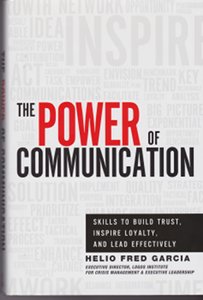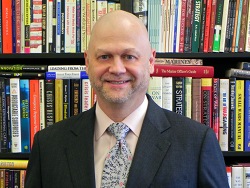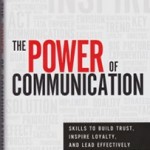Executive endorses strategic, operation, tactical communication
Posted by Elena del Valle on August 24, 2012

The Power of Communication book cover
Photo Helio Fred Garcia: Newman Communications
To be successful leaders must posses outstanding communication skills. That is the firm belief of Helio Fred Garcia, executive director, Logos Institute for Crisis Management and Executive Leadership. To master the skill of effective communication a leader must reach his or her audience where they are, he says.
In The Power of Communication: Skills to Build Trust, Inspire Loyalty, and Lead Effectively (FT Press, $26), published this year, he explains his thinking. He relies in part for his theories on Warfighting, the Marine Corps strategy doctrine military manual.
Communication has power that must be harnessed to keep it from backfiring, he says at the beginning of the book. At the same time, he believes that many of the principles necessary to lead armed forces are applicable to the discipline of public communication.
His goal in writing the book was to convert the Warfighting ideas into guidelines leaders can rely on for effective communication; share best practices lessons he has learned over his extensive years as a leadership consultant; and outline prominent case studies of communication failures and successes. Among the failures he cites Tony Hayward’s ineffectual handling of the 2010 BP Gulf of Mexico oil rig disaster and spill. He closes, in Chapter 10, with Nine Principles of Effective Leadership Communication.

Helio Fred Garcia, author, The Power of Communication
“Age by itself is not necessarily an issue, but generational temperament is. One of the core principles (Principle No. 2) is that if we are to move people, we need to meet them where they are. That includes knowing what they care about, knowing how they prefer to be engaged, and even knowing what their capacity is for engagement,” Garcia said by email in response to a question about the possible role of age or generation on the principles he proposes.
“One of the key drivers of engagement is attention span, and we’re finding that generations that have grown up with technology and television tend to have a shorter attention span than prior generations. So leaders need to adapt to be able to reach them. The generation that is growing up with social media is a multi-tasking generation. So leaders have a particular challenge engaging them. For example, in the book I point to research showing that there’s no such thing as multi-tasking. There’s only serial micro-tasking. But two tasks aren’t done simultaneously: when someone is doing one thing, he or she is not doing the other thing. But folks toggle in and out of each activity very quickly. That’s why distracted driving is such a problem. And also why leaders need to adapt their engagement strategy to deal with those who would otherwise be inclined to be easily distracted.”
In response to a question about the applicability of the concepts in his book to diverse audiences he responded: “Per the prior question, the key to moving people is meeting them where they are. I do a lot of work with religious groups, with students and clients in other cultures, in other countries, and and in other languages. The principles don’t change, but what is necessary to connect given cultural, linguistic, emotional, or spiritual concerns does.
I have taught these principles on five continents and in dozens of countries, and I have found that the principles work. But how they are executed is culturally varied. When I work with religious leaders (wherever I may be) I focus on authenticity and living our values. When I work with corporate leaders I focus on what works. When I work with academics I focus on what research shows.
But even within these groups there are further cultural issues. For example, when I’m teaching government leaders in China I don’t prescribe. I don’t say ‘Here’s what you should do if you want to accomplish X…’ Rather, I say, ‘Here’s what we know works in the United States. It would be inappropriate for me to presume that it works here, but if you find it useful I would be very gratified…’ That usually has people smiling and nodding their heads.
I find that audiences whose first language is not English have embraced the book. For example, last week I heard from students in an MBA program in Santiago, Chile, who are reading the book. They were assigned to do a class presentation on it, and they reached out to me for materials. Is sent them some slides, and a video introduction I recorded in Spanish. And I’ll be speaking about the book next month in Lima at the International Public Relations Association’s Latin American Congress and Global Conference. I will be doing introductions in both Spanish and Portuguese.”
The 295-page hardcover book is divided into ten chapters and three main parts: Leadership and Communication: Connecting with Audiences; Strategy and Communication: Planning and Execution (one chapter long); and Building Skills: Getting Good at Communicating Well.

Click to buy Power of Communication










